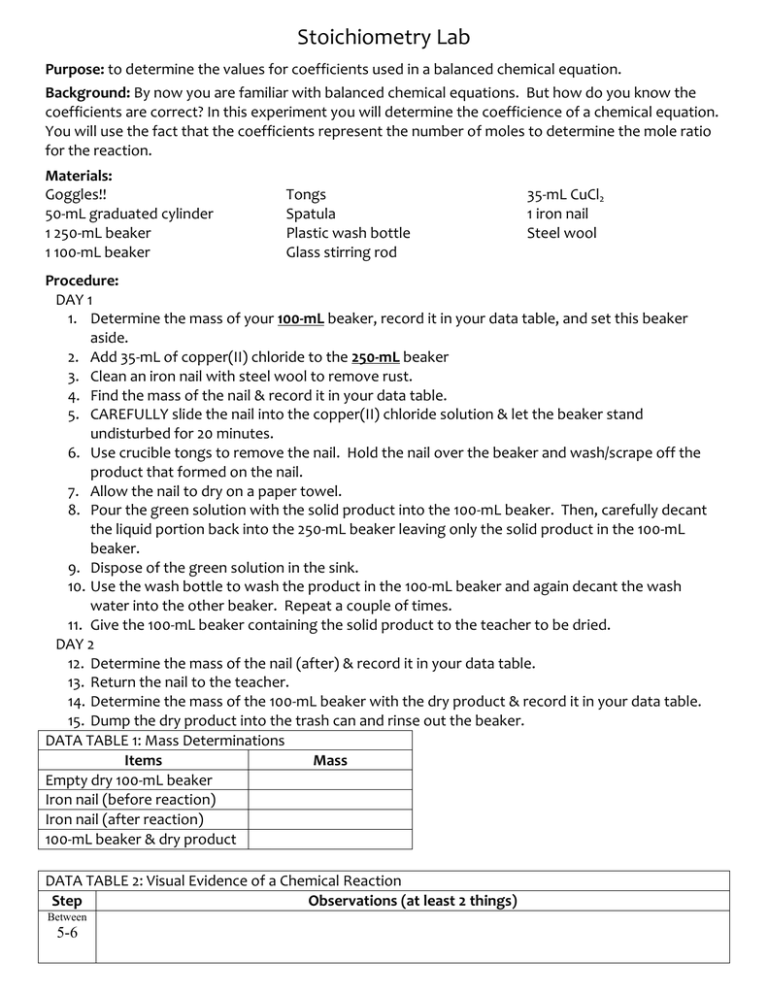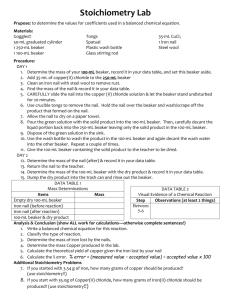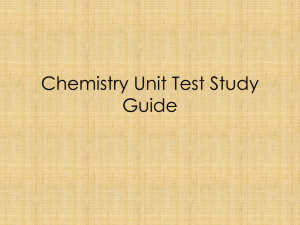Stoichiometry Lab
advertisement

Stoichiometry Lab Purpose: to determine the values for coefficients used in a balanced chemical equation. Background: By now you are familiar with balanced chemical equations. But how do you know the coefficients are correct? In this experiment you will determine the coefficience of a chemical equation. You will use the fact that the coefficients represent the number of moles to determine the mole ratio for the reaction. Materials: Goggles!! 50-mL graduated cylinder 1 250-mL beaker 1 100-mL beaker Tongs Spatula Plastic wash bottle Glass stirring rod 35-mL CuCl2 1 iron nail Steel wool Procedure: DAY 1 1. Determine the mass of your 100-mL beaker, record it in your data table, and set this beaker aside. 2. Add 35-mL of copper(II) chloride to the 250-mL beaker 3. Clean an iron nail with steel wool to remove rust. 4. Find the mass of the nail & record it in your data table. 5. CAREFULLY slide the nail into the copper(II) chloride solution & let the beaker stand undisturbed for 20 minutes. 6. Use crucible tongs to remove the nail. Hold the nail over the beaker and wash/scrape off the product that formed on the nail. 7. Allow the nail to dry on a paper towel. 8. Pour the green solution with the solid product into the 100-mL beaker. Then, carefully decant the liquid portion back into the 250-mL beaker leaving only the solid product in the 100-mL beaker. 9. Dispose of the green solution in the sink. 10. Use the wash bottle to wash the product in the 100-mL beaker and again decant the wash water into the other beaker. Repeat a couple of times. 11. Give the 100-mL beaker containing the solid product to the teacher to be dried. DAY 2 12. Determine the mass of the nail (after) & record it in your data table. 13. Return the nail to the teacher. 14. Determine the mass of the 100-mL beaker with the dry product & record it in your data table. 15. Dump the dry product into the trash can and rinse out the beaker. DATA TABLE 1: Mass Determinations Items Mass Empty dry 100-mL beaker Iron nail (before reaction) Iron nail (after reaction) 100-mL beaker & dry product DATA TABLE 2: Visual Evidence of a Chemical Reaction Step Observations (at least 2 things) Between 5-6 Analysis & Conclusion (show ALL work for calculations—otherwise complete sentences!) 1. Determine the mass of iron lost by the nails. 2. Calculate the number of moles of iron used. (use the mass from #1 to determine this) 3. Determine the mass of the product (mass product = 100-mL beaker & dry product - Empty dry 100-mL beaker)*from data table 1* 4. The solid product that formed was copper. Calcualte the number of moles of copper produced (use the mass from #3) 5. Calculate the mole ratio of iron used to copper produced (mol Fe/mol Cu). Also, express this as a simple whole-number ratio. 6. Calculate the % error in your value for the mole ratio. The accepted value is 1.0 % error = |measured value – accepted value| ÷ accepted value x 100 7. Some copper may have been lost during the experiment during the washing/decanting process. How would this effect the iron:copper ratio? Fe + CuCl2 FeCl2 + Cu 8. If you started with 3.54 g of iron, how many grams of copper should be produced? (use stoichiometry!!) 9. If you start with 35.0g of Copper(II) chloride, how many grams of Iron(II) chloride should be produced? (use stoichiometry!!)





